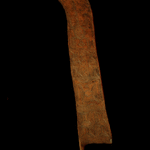Yoruba Brass Udamalore Ceremonial Sword, 19th Century CE - 20th Century CE
Brass
PF.5049
The ceremonial sword is an important symbol of power and authority. High ranking individuals wear the udamalore, (a small, ornate ceremonial sword), during festivals to designate them as someone of...
The ceremonial sword is an important symbol of power and authority. High ranking individuals wear the udamalore, (a small, ornate ceremonial sword), during festivals to designate them as someone of renown. At Ilesha, (central Yorubaland), the chief strikes the blade of his sword on the earth three times when he greets Ogun, god of iron. The sword is an emblem not only of wealth, but also of the power latent within the metal itself to cause either destruction or to protect. Just as an individual possessing power, both earthly and spiritual, may use the weapon for aggressive or passive purposes depending upon his judgment and wisdom.
The decoration on this sword contains three squares reaching roughly to the center, and the upper portion with an upside-down animal. The top and bottom squares have a floral motif with palmettes, petals and leaves. Two birds, one upright and the other inverted, are marked with horizontal and vertical lines to indicate plumage. The highly stylized animal on the upper section has a very long, straight tail, a bulbous body, triangular head and thick arms. It seems to be an amalgamation of different creatures--part mammal, lizard and snake; incorporating animals most often seen on Yoruba iconography.
The decoration on this sword contains three squares reaching roughly to the center, and the upper portion with an upside-down animal. The top and bottom squares have a floral motif with palmettes, petals and leaves. Two birds, one upright and the other inverted, are marked with horizontal and vertical lines to indicate plumage. The highly stylized animal on the upper section has a very long, straight tail, a bulbous body, triangular head and thick arms. It seems to be an amalgamation of different creatures--part mammal, lizard and snake; incorporating animals most often seen on Yoruba iconography.



